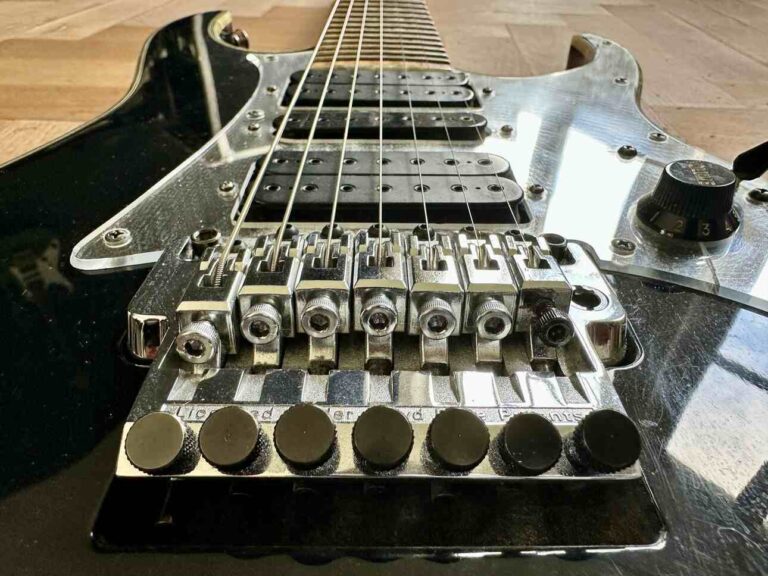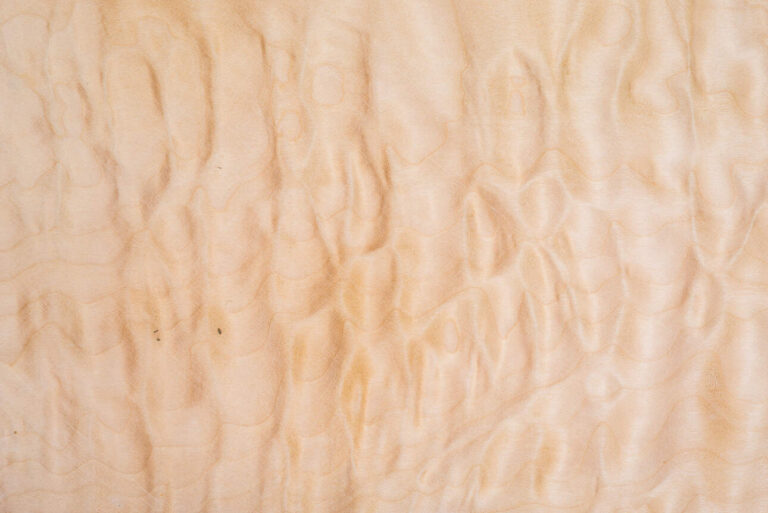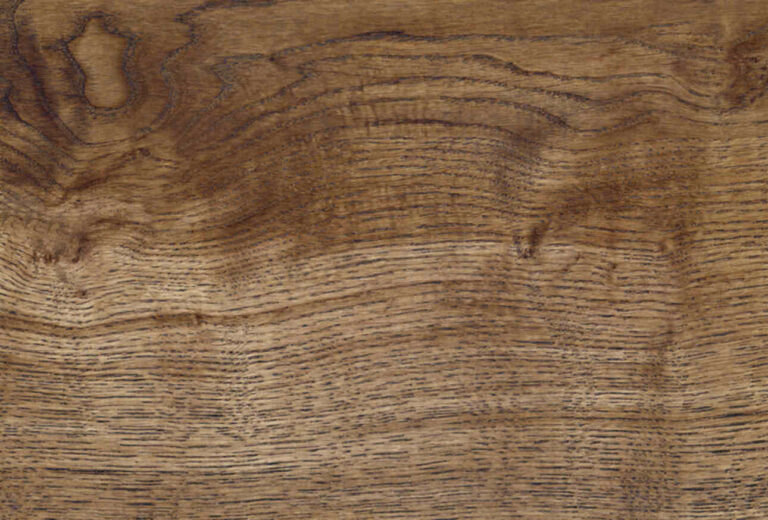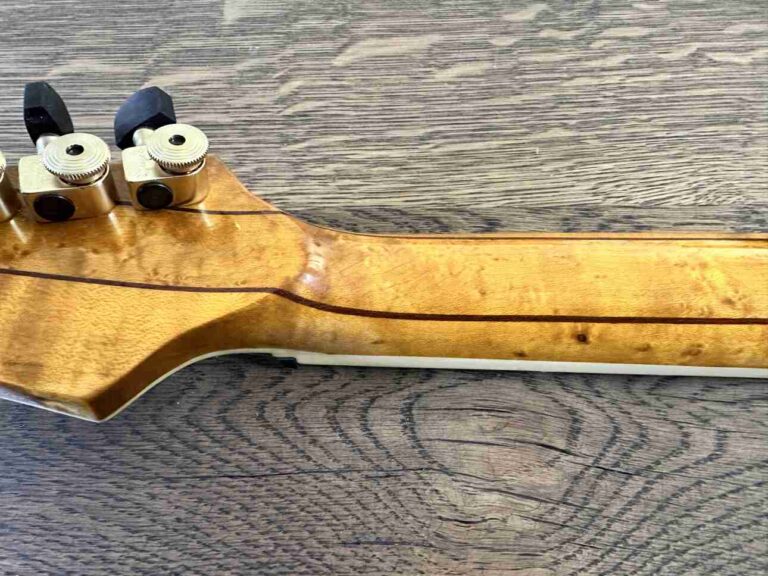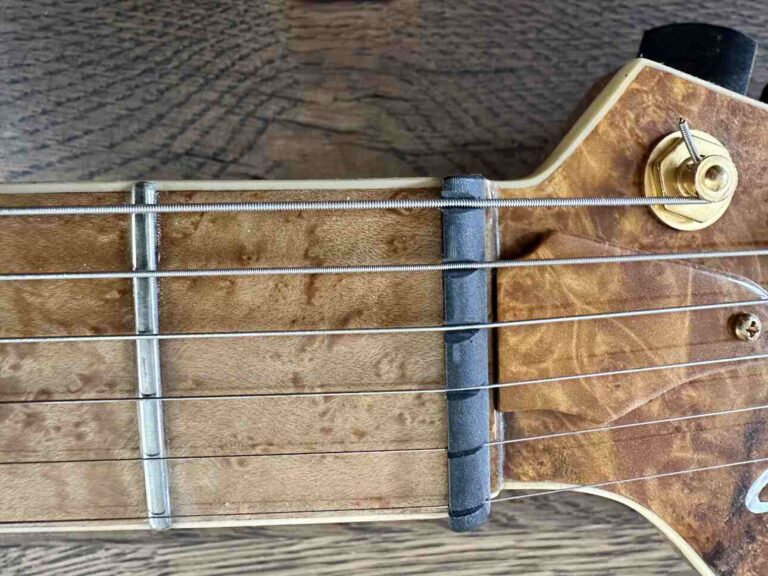Does the Wood of A Guitar Neck Affect the Tone?
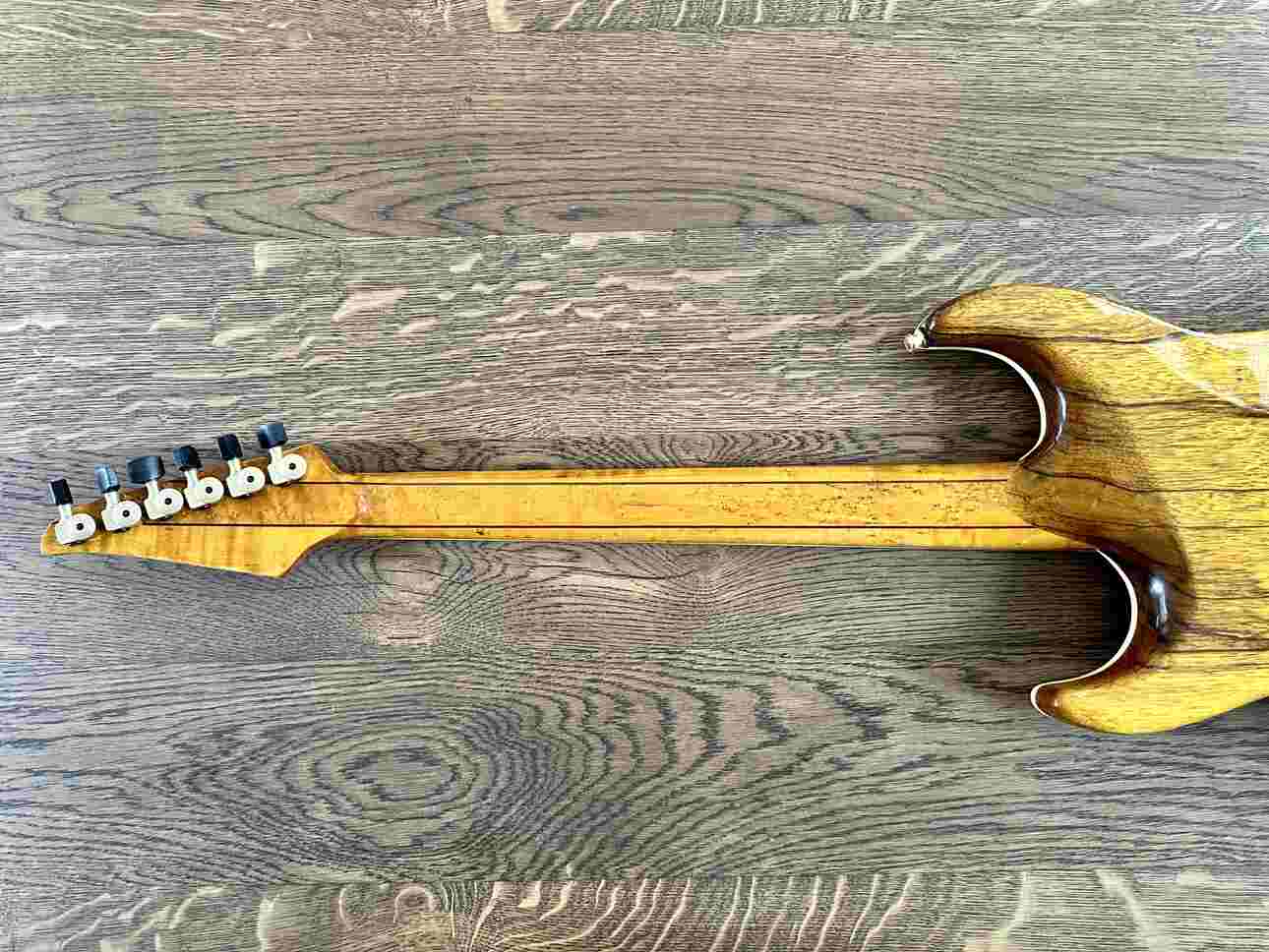
The construction of a guitar plays a big part in its sound, so yes, the neck and the wood it’s made of do matter. There’s a lot of talk about how the choice of wood for a guitar’s neck affects its tone. Let’s take a look at why neck wood is key to the sound of a guitar.
Every type of wood has its own features, like how heavy or stiff it is, which changes how a guitar vibrates and sounds. Some research has looked at various woods for different guitar parts, including the neck, to see how they change the tone.
But it’s not just about the wood – how the guitar feels and how easy it is to play can also affect how we think it sounds.
So, when picking out a guitar, remember that the neck wood is more than just a look. It’s part of what makes your guitar sound the way it does.
Key Takeaways
- The wood used for a guitar neck can influence your instrument’s tone;
- Woods have different densities and stiffness, which can affect how a guitar vibrates and the sound it makes;
- How the guitar feels in your hands and how easy it is to play can shape how you hear its tone.
Fundamentals of Guitar Tone
The Role of the Neck in Sound Production
When you strum or pick a guitar’s strings, their vibrations zip through the neck. The neck is super important for the guitar’s tone because it affects how well the strings vibrate and pass that sound on to the guitar’s body.
The type of wood, how dense it is, and how stiff it is can all change how those vibrations move. It can change what the guitar sounds like.
Material Impact on Vibration and Resonance
Picking the right wood for your guitar neck is key if you’re chasing a specific sound. Different woods can change how your guitar resonates and vibrates.
For example, harder woods like maple give you a sharper, clearer tone, while softer woods like mahogany have a warmer, richer vibe.
When you’re on the hunt for the perfect neck wood, think about what each material brings to the table. The denseness or stiffness can influence how the vibrations move through your guitar.
It’s all about what you like and the sound you’re after.
Don’t be afraid to try different woods to see what clicks with your guitar. It’s all about mixing and matching those wood traits with the vibrations that make your guitar’s sound special.
Characteristics of Neck Construction
Neck Wood Varieties
You’ve got a few crowd favorites like maple, mahogany, rosewood, and sometimes spruce. Each wood brings its own flavor to the music.
Take maple: it’s known for giving you a bright and lively tone. A Fender Strat often comes with a maple neck.
Mahogany on the other hand gives a warm, full sound. A Gibson Les Paul usually has a mahogany neck.
The neck wood often comes with a tag-team partner, the fingerboard wood. You might see rosewood sitting on top of a maple neck. Mixing up these woods can give you a rich blend of sounds, making your guitar’s tone even more interesting.
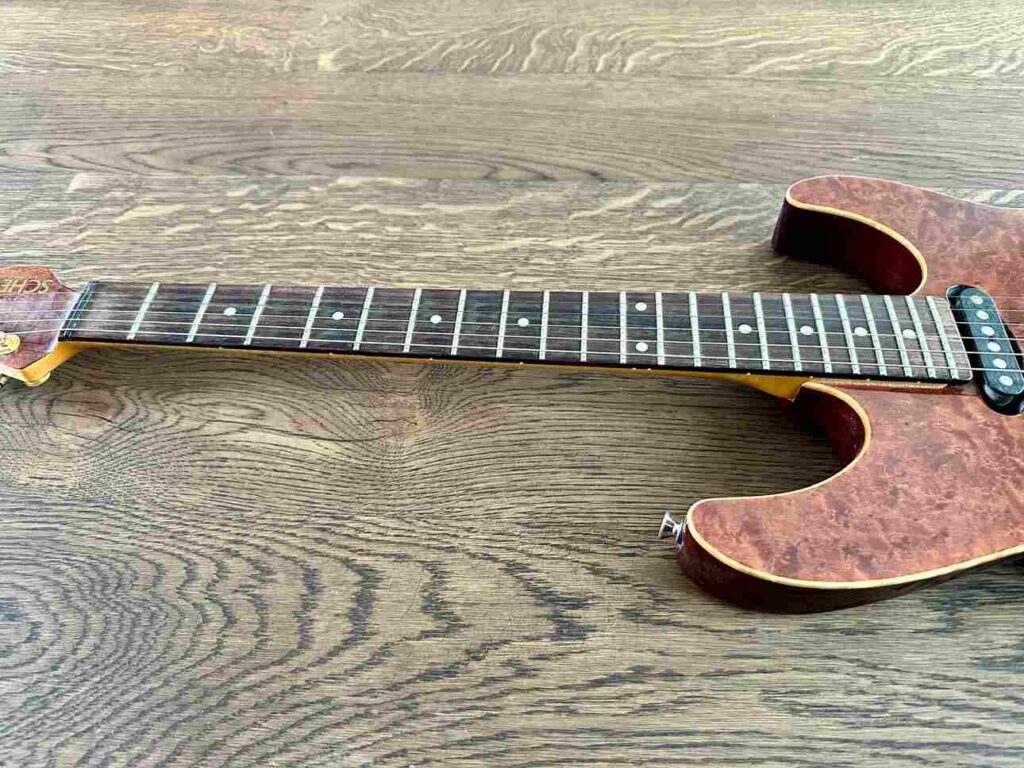
Neck Dimensions and Mass
Yes, the size and weight of the guitar neck are just as important as the wood choice when it comes to tone. A thicker, heavier neck usually means a deeper and warmer sound, while a thinner, lighter neck tends to bring out a brighter, more energetic tone.
Tweaking the neck’s thickness or weight can also change how the guitar feels when you play it. It’s all about striking the right balance between the neck’s dimensions, the wood type, and what feels good in your hands.
This balance helps you get the sound and comfort level that’s just right for your playing style.
How Neck Wood Affects Playability and Comfort
The neck’s wood is a big deal for how your guitar sounds and feels when you’re playing. The material of the neck can change the tone and the comfort level.
Let’s talk about the fretboard – that’s where your fingers do their magic, pressing strings down on the frets. Different woods here can make a big difference.
For example, rosewood fretboards are smooth, making for a comfy playing experience, while maple fretboards can make the tone pop a bit more.
But it’s not just about the wood. The neck’s shape and thickness matter, too. Slim necks are super user-friendly – they’re easy to hold and move around on.
Thicker necks, the kind you’d find on a classical guitar, offer more support for your hand.
And the neck influences playability, from the feel in your hand to how simple it is to hit those high notes.
Some folks are all about thin necks because they’re sleek and easy to play. Others go for thick necks for a solid grip. It’s all about what fits your style and hands the best.
The material of the neck can change
the tone and the comfort level
Comparative Analysis of Neck Woods
Tonewood’s Effect on Tone and Sustain
The wood used for a guitar neck, often called ‘tonewood‘, is a key player in shaping the instrument’s sound. Different woods can indeed give your guitar a distinct tone.
For instance, many players notice that a dense wood like maple can sustain notes longer and tends to sound brighter. But a more open-grained wood like mahogany is thought to produce a warmer, softer tone.
Looking at tonewoods can give you insight into how each material contributes to the unique character of a guitar’s sound.
But it’s worth mentioning that there’s still some back-and-forth about just how much the neck wood changes tone and sustain.
Things like the quality of the wood and how the guitar is put together also play big roles in shaping the sound.
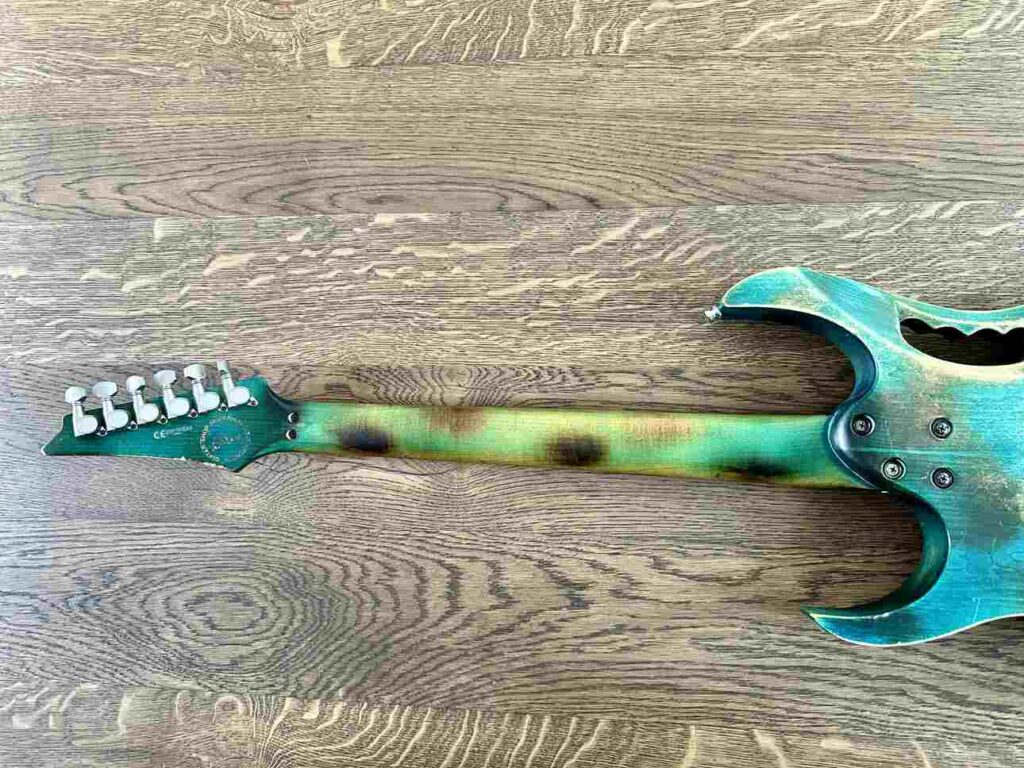
Perceived Versus Actual Sound Change
The link between a guitar’s tone and the wood of its neck isn’t always clear-cut. Sometimes, what we think we hear in different tones can be down to personal taste or how we perceive the sound.
Research suggests that the tonal differences from various fingerboard woods might be so slight that most people wouldn’t even notice them. But it’s not all about the sound—the feel of the guitar neck plays a big part, too.
The finish on the wood, the neck’s shape, and the curve of the fretboard can all affect how you interact with the guitar. It can change your playing style and, by extension, the tone you produce.
Community and Expert Opinions
Anecdotal Evidence and Testimonials
There’s a lot of debate among guitar players about how much the wood of the neck affects the guitar’s sound. Some players believe certain woods make a big difference, while others think it’s not crucial.
Guitarists often share their experiences with different woods on online platforms like The Gear Page and forums like Guitar Stack Exchange, as well as on various YouTube guitar channels.
But it’s not just about what people believe or their individual experiences. When looking at what shapes a guitar’s tone, you’ve got to consider other stuff, too, like how it’s built, the pickups, the strings, and even the way you play. So, even if neck wood does change the sound a bit, it’s just one piece of a bigger puzzle.
For some players, the choice of neck wood might be more about the feel or look of the guitar. Maybe they just like how a certain wood feels in their hands, or they’re into the way it looks. The wood might not make a huge difference in tone in these cases, but it’s still a big part of why they love playing that guitar.
Scientific Studies and Industry Insights
It’s true that while stories and personal experiences are valuable, they’re just part of the picture. To understand the role of neck wood in guitar tone, we also need to look at scientific studies and what the pros in the industry have to say.
One study suggests guitarists can tell the difference when they play on guitars with different fingerboard woods. But there could be – still unknown – other reasons for those differences.
Industry experts can also shed light on how different woods perform under various conditions. Like how they’re put together or their climate. But every expert brings their own experiences to the table, so their views might differ. Checking out a range of expert opinions can give you a well-rounded understanding of the issue.
Frequently Asked Questions
How can different woods influence the tone of an electric guitar?
Different woods can alter an electric guitar’s tone by changing its sound and resonance due to its varying density and hardness. The neck wood especially contributes to the sound quality.
What impact does the wood of a guitar neck have on sound quality?
The wood of a guitar neck affects the instrument’s timbre, sustain, and projection. Since the neck contributes to the guitar’s stiffness and stability, it produces a consistent tone.
Is there a notable difference in tone between various neck woods?
Yes, different neck woods can lead to distinct tones. Denser woods like mahogany typically yield a warm sound, while lighter woods like maple are known for a brighter tone. But the tone difference due to neck wood may not be as significant as that caused by the body wood.
What characteristics of wood contribute to a guitar’s resonance and sustain?
The wood’s density, hardness, and mass influence a guitar’s resonance and sustain. Denser woods typically offer better sustain and a more concentrated resonance. Lighter woods can provide a more open sound.
Can the type of wood of a guitar neck alter the instrument’s sound?
Yes, the wood used for a guitar’s neck can slightly affect the sound. Choosing the right wood for the neck, along with other parts like the body and electronics, can improve the sound you want from your guitar.
Why might a musician prefer a roasted maple neck for their guitar in terms of tone?
A roasted maple neck has been treated to reduce moisture and impurities. This makes it more stable, lighter, and resonant. This process can enrich the tone with greater sustain and warmth, so musicians may favor it for both tonal benefits and reliability.

